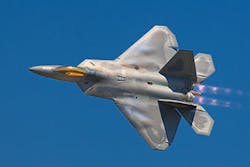Lockheed Martin test pilot talks fighter aircraft innovations in situational awareness, sensor payloads
MONTREAL, 3 Dec. 2013. Lockheed Martin Test Pilot Billie Flynn opened the second day of the Aerospace Innovation Forum in Montreal with a talk about innovations in military fighter aircraft.
The key to pushing the envelope currently is to take the human, who has historically been the limiting factor, out of the equation to push what the aircraft itself can do, Flynn says. The F-22 was the start of that new paradigm.
To do more with less, innovation is required. The current expectations include: fighter performance, advanced sensors, network-enabled operations, peace-keeping capabilities, long range, and affordable.
Even if you want everything in a single airplane, you’re not going to satisfy everyone out there with one aircraft. “We changed the notion of aerial warfare,” Flynn explains. “Combat is done with air power now, but you can’t achieve that with the same basing requirements in every jet.”
Lockheed Martin, working with Magellan Aerospace, have enabled an airplane to hover. “There is a need to take off and land vertically and on very short strips” and fourth-generation aircraft fulfilled that need, says Flynn, who calls the short take-off and vertical landing (STOVL) aircraft “an astonishing piece of equipment, but for the pilot simple but sophisticated.”
Connectivity and visualization in the cockpit are critical. “Big screens, touchscreens not buttons, high fidelity in front of the pilot’s head—wherever he looks he sees what’s around him,” Flynn describes, “and broadband connectivity to ensure everyone has the same amount of information.”
Pilots have long had sensors to help them; we wanted to add as many sensors as possible. On the F-18, we added a pod on the outside. Historically, pilots have had to manage sensors; they would decide what to look at and do their best to figure out what’s important while he is busy flying the airplane.
“It was never going to get better as long as the human was in the loop. With the F-22, we finessed sensor fusion—fusion of sensor data, 8.6 million lines of software code to figure out if information is relevant. The pilot is no longer a limiter in that and he’s more effective; let him fly the airplane,” says Flynn.
Innovations of the future will continue this trend of enabling us to do more with less, Flynn says. The future is hypersonics, unmanned fighters, and heavy-lift innovations.

Courtney E. Howard | Chief Editor, Intelligent Aerospace
Courtney enjoys writing about all things high-tech in PennWell’s burgeoning Aerospace and Defense Group, which encompasses Intelligent Aerospace and Military & Aerospace Electronics. She’s also a self-proclaimed social-media maven, mil-aero nerd, and avid avionics and space geek. Connect with Courtney at [email protected], @coho on Twitter, on LinkedIn, and on Google+.

